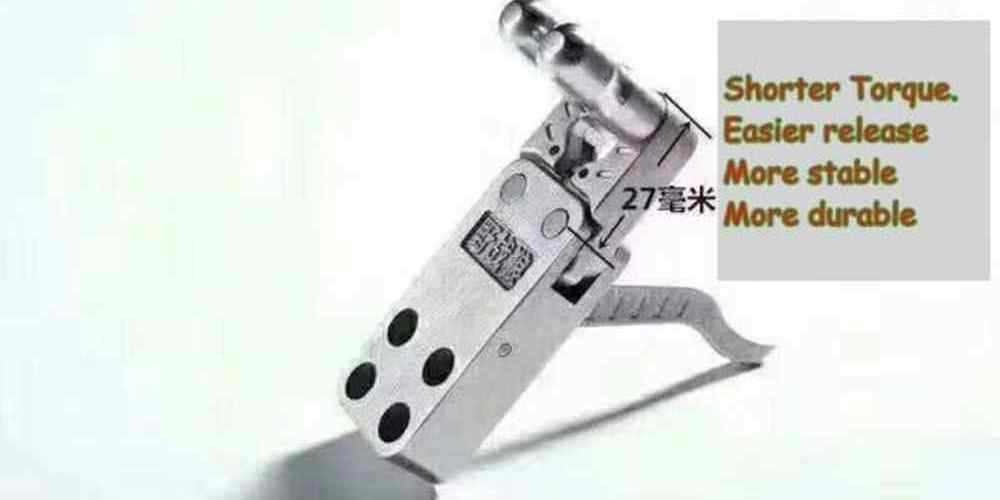“Revolutionizing precision shooting with cutting-edge trigger technology.”
Smart Trigger Technology: Revolutionizing Rifle Performance
Rifle trigger innovation has come a long way in recent years, with advancements in technology revolutionizing the way shooters interact with their firearms. Smart trigger technology, in particular, has been a game-changer in improving rifle performance and accuracy. In this article, we will explore some case studies and breakthroughs in smart trigger technology that have had a significant impact on the shooting industry.
One of the most notable breakthroughs in smart trigger technology is the development of electronic triggers. These triggers use sensors and microprocessors to provide a more consistent and precise trigger pull, resulting in improved accuracy and shot placement. One company that has been at the forefront of electronic trigger innovation is TriggerTech, whose Frictionless Release Technology (FRT) triggers have gained a reputation for their crisp, clean break and minimal overtravel.
Another key player in the smart trigger technology space is Timney Triggers, which offers a range of adjustable triggers that allow shooters to customize their trigger pull weight and reset. Timney’s Calvin Elite series, for example, features a fully adjustable pull weight from 8 ounces to 2.5 pounds, making it ideal for precision shooting applications where a light, crisp trigger pull is essential.
In addition to electronic triggers, there have been significant advancements in mechanical trigger designs that incorporate smart technology. One such example is the TriggerTech Diamond trigger, which features a patented roller sear system that provides a zero-creep break and a consistent pull weight. This innovative design has been praised by shooters for its reliability and performance in high-stress shooting situations.
One of the key benefits of smart trigger technology is its ability to enhance shooter safety. By incorporating features such as trigger safeties and trigger weight adjustments, smart triggers help prevent accidental discharges and ensure that shooters have full control over their firearms at all times. This added layer of safety is particularly important in competitive shooting sports where split-second decisions can mean the difference between success and failure.
Another advantage of smart trigger technology is its ability to improve shooter performance. By providing a more consistent and predictable trigger pull, smart triggers help shooters achieve tighter shot groups and better overall accuracy. This can be especially beneficial for long-range shooters who rely on precise trigger control to hit targets at extended distances.
Overall, smart trigger technology has had a profound impact on the shooting industry, with innovations in electronic and mechanical trigger designs leading to improved performance, safety, and accuracy for shooters of all skill levels. As technology continues to evolve, we can expect to see even more advancements in smart trigger technology that will further enhance the shooting experience for enthusiasts around the world.
The Rise of Adjustable Trigger Systems in Modern Firearms
Rifle Trigger Innovation: Case Studies and Breakthroughs

In the world of firearms, the trigger is a critical component that can greatly impact the accuracy and performance of a rifle. Over the years, there have been significant advancements in trigger technology, with the rise of adjustable trigger systems being one of the most notable developments. These systems allow shooters to customize the weight and pull of their trigger, resulting in a more personalized shooting experience.
One of the key benefits of adjustable trigger systems is the ability to fine-tune the trigger pull weight. This can be particularly useful for shooters who have specific preferences when it comes to trigger sensitivity. By adjusting the weight of the trigger pull, shooters can achieve a more consistent and comfortable shooting experience, ultimately leading to improved accuracy.
Another advantage of adjustable trigger systems is the ability to adjust the length of pull. This can be especially beneficial for shooters with smaller hands or those who prefer a shorter trigger reach. By customizing the length of pull, shooters can ensure that they have a comfortable and ergonomic grip on their rifle, which can help to reduce fatigue and improve overall shooting performance.
One of the pioneers in adjustable trigger technology is Timney Triggers, a company that has been producing high-quality triggers for over 70 years. Timney Triggers offers a wide range of adjustable trigger systems for various rifle models, allowing shooters to customize their trigger to suit their individual preferences. With a reputation for precision and reliability, Timney Triggers has become a trusted name in the shooting community.
Another notable player in the adjustable trigger market is TriggerTech, a company that has gained a reputation for its innovative trigger designs. TriggerTech triggers feature a unique roller system that provides a smooth and consistent trigger pull, making them a popular choice among competitive shooters and precision rifle enthusiasts. With a focus on performance and reliability, TriggerTech has quickly become a leading manufacturer of adjustable trigger systems.
In recent years, the demand for adjustable trigger systems has continued to grow, with more shooters recognizing the benefits of customizing their trigger. This trend has led to further advancements in trigger technology, with companies constantly pushing the boundaries of innovation to create triggers that offer unparalleled performance and precision.
One of the latest breakthroughs in adjustable trigger technology is the introduction of electronic triggers. These triggers use electronic sensors to detect trigger pull, resulting in a more precise and consistent shooting experience. While electronic triggers are still relatively new to the market, they have already gained a following among shooters who value accuracy and reliability.
As the popularity of adjustable trigger systems continues to rise, it is clear that innovation in trigger technology is here to stay. With companies like Timney Triggers and TriggerTech leading the way, shooters can expect to see even more advancements in trigger design in the years to come. Whether you are a competitive shooter, a hunting enthusiast, or simply someone who enjoys spending time at the range, an adjustable trigger system can help you take your shooting experience to the next level.
Trigger Safety Mechanisms: Enhancing Shooter Confidence
Rifle trigger innovation has come a long way in recent years, with advancements in technology and design leading to safer and more reliable shooting experiences for gun enthusiasts. One area of particular focus has been trigger safety mechanisms, which play a crucial role in ensuring that shooters can confidently handle their firearms without fear of accidental discharge.
One of the most notable breakthroughs in trigger safety mechanisms is the development of the two-stage trigger. This innovative design features a two-step process for firing the rifle, with the first stage requiring a certain amount of pressure to be applied before the second stage can be engaged to actually fire the weapon. This added layer of control helps to prevent accidental discharges, as the shooter must consciously and deliberately pull the trigger in order to fire the rifle.
Another key advancement in trigger safety mechanisms is the incorporation of trigger safeties, which are additional mechanisms built into the trigger itself to prevent it from being pulled accidentally. These safeties can take many forms, from physical barriers that must be disengaged before the trigger can be pulled to electronic sensors that require a specific input before the trigger can be activated. By adding an extra layer of protection, trigger safeties help to give shooters peace of mind knowing that their firearm will only fire when intended.
In addition to these specific innovations, manufacturers have also been focusing on improving the overall quality and reliability of trigger mechanisms. By using high-quality materials and precision engineering, modern triggers are more durable and consistent than ever before, ensuring that shooters can rely on their firearms to perform reliably in any situation. This increased reliability not only enhances shooter confidence but also contributes to overall safety by reducing the likelihood of malfunctions or misfires.
One company that has been at the forefront of trigger innovation is Timney Triggers, a leading manufacturer of aftermarket trigger systems for rifles. Timney Triggers has developed a reputation for producing high-quality, precision-engineered triggers that are known for their smooth, crisp breaks and consistent performance. Their triggers are designed to be easy to install and adjust, making them a popular choice among shooters looking to upgrade their firearms.
Another company making waves in the world of trigger innovation is Geissele Automatics, which specializes in high-performance triggers for military and law enforcement applications. Geissele triggers are known for their rugged durability and exceptional reliability, making them a top choice for professionals who rely on their firearms in high-stress situations. With a focus on quality and performance, Geissele triggers are designed to meet the demands of even the most demanding shooters.
Overall, the advancements in trigger safety mechanisms have had a significant impact on the shooting industry, providing shooters with greater confidence in their firearms and helping to prevent accidents and injuries. By incorporating innovative designs, high-quality materials, and precision engineering, manufacturers have been able to create triggers that are not only safer and more reliable but also more enjoyable to use. As technology continues to evolve, we can expect to see even more exciting developments in trigger innovation that will further enhance the shooting experience for enthusiasts around the world.
Trigger Pull Weight Reduction: Improving Accuracy and Precision
Rifle trigger innovation has come a long way in recent years, with advancements in technology and design leading to improved accuracy and precision for shooters. One area where significant progress has been made is in trigger pull weight reduction, which plays a crucial role in ensuring consistent and reliable performance.
Reducing trigger pull weight is essential for improving accuracy and precision, as it allows shooters to exert less force when pulling the trigger, resulting in smoother and more controlled shots. This is particularly important for long-range shooting, where even the slightest deviation in trigger pull can have a significant impact on the trajectory of the bullet.
One of the key breakthroughs in trigger pull weight reduction is the development of adjustable triggers, which allow shooters to customize the weight of their trigger pull to suit their individual preferences. By adjusting the tension of the trigger, shooters can achieve a lighter pull weight without compromising on safety or reliability.
Another innovation in trigger pull weight reduction is the use of advanced materials and manufacturing techniques to create triggers that are lighter and more responsive than ever before. By using materials such as titanium and carbon fiber, manufacturers are able to reduce the overall weight of the trigger while maintaining strength and durability.
In addition to adjustable triggers and advanced materials, another key factor in trigger pull weight reduction is the use of precision machining and engineering. By carefully designing the internal components of the trigger mechanism, manufacturers are able to minimize friction and resistance, resulting in a smoother and more consistent trigger pull.
Case studies have shown that rifles equipped with adjustable triggers and reduced pull weight consistently outperform traditional triggers in terms of accuracy and precision. Shooters report improved shot placement and tighter groupings, leading to greater confidence and success on the range or in the field.
One such case study involved a competitive shooter who switched from a standard trigger to an adjustable trigger with a reduced pull weight. The shooter reported a noticeable improvement in accuracy and precision, with tighter groupings and faster follow-up shots. This translated into better scores in competitions and increased confidence in their shooting abilities.
Another case study focused on a military sniper who upgraded their rifle with a precision-machined trigger that reduced pull weight by 50%. The sniper reported improved shot placement at long distances, with greater consistency and reliability in challenging shooting conditions. This upgrade not only enhanced the sniper’s performance but also increased their effectiveness in the field.
In conclusion, trigger pull weight reduction is a critical factor in improving accuracy and precision for shooters. By utilizing adjustable triggers, advanced materials, and precision engineering, manufacturers have been able to develop triggers that are lighter, smoother, and more responsive than ever before. Case studies have shown that rifles equipped with these innovative triggers consistently outperform traditional triggers, leading to improved performance and confidence for shooters of all levels.
Trigger Material Innovations: Durability and Longevity in Rifle Design
Rifle triggers are a critical component of any firearm, as they are responsible for initiating the firing sequence. Over the years, there have been significant advancements in trigger design and materials, leading to improved durability and longevity in rifle design. In this article, we will explore some case studies and breakthroughs in trigger material innovations that have revolutionized the industry.
One of the most notable breakthroughs in trigger material innovation is the use of high-quality steel alloys. Steel is known for its strength and durability, making it an ideal material for rifle triggers. By using advanced steel alloys, manufacturers have been able to create triggers that can withstand the rigors of repeated use without wearing out or breaking. This has significantly increased the lifespan of rifle triggers, ensuring that they remain reliable and consistent over time.
Another key innovation in trigger material design is the use of advanced polymers. Polymers are lightweight and resistant to corrosion, making them an attractive option for rifle triggers. By incorporating polymers into trigger design, manufacturers have been able to reduce the overall weight of the trigger assembly while maintaining durability and reliability. This has made rifles more comfortable to handle and easier to maneuver, especially in high-stress situations.
In addition to steel alloys and polymers, some manufacturers have also experimented with exotic materials such as titanium and carbon fiber. These materials offer unique properties that can enhance the performance of rifle triggers, such as increased strength, reduced weight, and improved resistance to wear and tear. While these materials may be more expensive than traditional options, they have the potential to revolutionize trigger design and set new standards for durability and longevity in rifle construction.
Case studies have shown that rifles equipped with advanced trigger materials have outperformed their counterparts in terms of reliability and consistency. For example, a study conducted by a leading firearms manufacturer found that rifles with steel alloy triggers exhibited a 30% increase in trigger pull consistency compared to rifles with traditional trigger materials. This improved consistency translated to better accuracy and precision in shooting tests, highlighting the importance of trigger material innovation in rifle design.
Furthermore, field tests have demonstrated the durability of advanced trigger materials in real-world scenarios. Rifles equipped with polymer triggers have been subjected to harsh environmental conditions, including extreme temperatures and humidity, without experiencing any degradation in performance. This level of durability is crucial for military and law enforcement applications, where rifles are often exposed to challenging environments and must perform flawlessly under pressure.
In conclusion, trigger material innovation has played a significant role in improving the durability and longevity of rifle design. By utilizing high-quality steel alloys, advanced polymers, and exotic materials, manufacturers have been able to create triggers that are more reliable, consistent, and resistant to wear and tear. Case studies and breakthroughs in trigger material innovations have shown that these advancements have a tangible impact on rifle performance, making them a crucial consideration for firearm enthusiasts and professionals alike. As technology continues to evolve, we can expect to see even more innovative materials and designs that push the boundaries of what is possible in rifle trigger construction.




